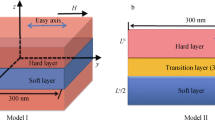Abstract
Analyzing the magnetization reversal process is crucial for enhancing the magnetic properties of nanocomposite magnets, thereby subsequently increasing the magnetic energy product and advancing the development of next-generation rare earth permanent magnet materials. Here, the open recoil loop is systematically investigated based on micromagnetic simulations and comparing magnetization configurations, which is strongly associated with the asymmetric behavior of weak pinning at the soft/hard magnetic interface. By removing and reapplying field, the irreversible weak pinning sites exhibit asymmetric behavior, leading to the formation of open phenomena in nanocomposites. The open degree of recoil loops obtained from experimental testing was also correlated with the irreversible magnetization, which supports the simulation results. Our findings provide a novel approach for understanding the magnetization reversal mechanism in nanocomposite magnets.





Similar content being viewed by others
Data availability
The data that support the findings of this study are available from the corresponding authors upon reasonable request.
References
Skomski R, Coey JMD (1993) Giant energy product in nanostructured two-phase magnets. Phys Rev B 48:15812–15816
Wang FQ, Hu XJ, Liu YH, Zhang J (2022) Preparation and control mechanism of anisotropic Sm–Pr–Co/Co nanocomposites with unusual continuous soft-phase coatings. J Rare Earth 40:1091–1097
Teng Y, Li YQ, Xu XC, Yue M, Liu WQ, Zhang DT, Zhang HG, Lu QM, Xia WX (2023) Microstructure evolution of hot-deformed SmCo-based nanocomposites induced by thermo-mechanical processing. J Mater Sci Technol 138:193–202
Cui WB, Takahashi YK, Hono K (2012) Nd2Fe14B/FeCo anisotropic nanocomposite films with a large maximum energy product. Adv Mater 24:6530–6535
Neu V, Sawatzki S, Kopte M, Mickel C, Schultz L (2012) Fully epitaxial, exchange coupled SmCo5/Fe multilayers with energy densities above 400 kJ/m3. IEEE Trans Magn 48:3599–3602
Li XH, Lou L, Song WP, Huang GW, Hou FC, Zhang Q, Zhang HT, Xiao JW, Wen B, Zhang XY (2017) Novel bimorphological anisotropic bulk nanocomposite materials with high energy products. Adv Mater 29:1606430
Zhang XY (2020) Heterostructures: new opportunities for functional materials. Mater Res Lett 8:49–59
Liu YG, Xu L, Wang QF, Li W, Zhang XY (2009) Development of crystal texture in Nd-lean amorphous Nd9Fe85B6 under hot deformation. Appl Phys Lett 94:172502
Li HL, Li XH, Guo DF, Lou L, Li W, Zhang XY (2016) Three-dimensional self-assembly of core/shell-like nanostructures for high-performance nanocomposite permanent magnets. Nano Lett 16:5631–5638
Li HL, Lou L, Hou FC, Guo DF, Li W, Li XH, Gunderov DV, Sato K, Zhang XY (2013) Simultaneously increasing the magnetization and coercivity of bulk nanocomposite magnets via severe plastic deformation. Appl Phys Lett 103:142406
Li XH, Lou L, Song WP, Zhang Q, Huang GW, Hua YX, Zhang HT, Xiao JW, Wen B, Zhang XY (2017) Controllably manipulating three-dimensional hybrid nanostructures for bulk nanocomposites with large energy products. Nano Lett 17:2985–2993
Rong CB, Nandwana V, Poudyal N, Li Y, Liu JP, Ding Y, Wang ZL (2007) Formation of Fe3Pt phase in FePt-based nanocomposite magnets. J Phys D Appl Phys 40:712–716
Choi Y, Jiang JS, Pearson JE, Bader SD, Liu JP (2007) Origin of recoil hysteresis loops in Sm–Co/Fe exchange-spring magnets. Appl Phys Lett 91:022502
Rong CB, Liu JP (2009) Effect of thermal fluctuations on the recoil loops of SmCo5/Fe nanocomposite system. J Appl Phys 105:07A714
Rong CB, Liu JP (2009) Grain boundary contribution to recoil loop openness of exchange-coupled nanocrystalline magnets. Appl Phys Lett 94:172510
Donahue MJ, Porter DG (1999) OOMMF user’s guide, version 1.0, National Institute of Standards and Technology, Gaithersburg
Zhao GP, Wang XL (2006) Nucleation, pinning, and coercivity in magnetic nanosystems: an analytical micromagnetic approach. Phys Rev B 74(1):012409
Kronmüller H, Goll D (2002) Micromagnetic analysis of nucleation-hardened nanocrystalline PrFeB magnets. Scripta Mater 47(8):551–556
Zhang HW, Rong CB, Zhang J, Zhang SY, Shen BG (2002) Coercivity of isotropic nanocrystalline Pr12Fe82B6 ribbons. Phys Rev B 66(18):184436
Zhuge YT, Li YQ, Xu XC, Zhang DT, Zhang HG, Liu WQ, Yue M (2021) Morphology and magnetic properties of Sm2Co7/α-Fe nanocomposite magnets produced by high energy ball milling and spark plasma sintering. J Rare Earth 39:312–316
Li YQ, Teng Y, Xu XC, Zhang Y, Yue M (2021) Simulation on the openness in recoil loop of nanocomposite magnet. J Magn Magn Mater 538:168261
Schrefl T, Fischer R, Fidler J, Kronmuller H (1994) Two‐and three‐dimensional calculation of remanence enhancement of rare‐earth based composite magnets. J Appl Phys 76:7053–7058
Zhao G, Wang X (2006) Nucleation, pinning, and coercivity in magnetic nanosystems: an analytical micromagnetic approach. Phys Rev B 74:012409
Zhao G, Wang X, Yang C, Xie L, Zhou G (2007) Self-pinning: dominant coercivity mechanism in exchange-coupled permanent/composite magnets. J Appl Phys 101:09K102
Zhao G, Zhao L, Shen L, Zou J, Qiu L (2019) Coercivity mechanisms in nanostructured permanent magnets. Chin Phys B 28:077505
Acknowledgements
This work was supported by the National Key R&D Program of China (No. 2021YFB3500300), the National Natural Science Foundation of China (Nos. 51931007, 52371170), the Program of Top Disciplines Construction in Beijing (Grant PXM2019_014204_500031).
Author information
Authors and Affiliations
Corresponding authors
Ethics declarations
Conflict of interest
The authors have no conflicts to disclose.
Additional information
Handling Editor: Ghanshyam Pilania.
Publisher's Note
Springer Nature remains neutral with regard to jurisdictional claims in published maps and institutional affiliations.
Supplementary Information
Below is the link to the electronic supplementary material.
10853_2024_9629_MOESM1_ESM.docx
The supplementary materials include three figures, S1–S3, which respectively illustrate the magnetization configuration at H = − 15.8 kOe, the magnetization configuration of the closed recoil loops, and the magnetization configuration of the open recoil loop. (DOCX 1297 KB)
Rights and permissions
Springer Nature or its licensor (e.g. a society or other partner) holds exclusive rights to this article under a publishing agreement with the author(s) or other rightsholder(s); author self-archiving of the accepted manuscript version of this article is solely governed by the terms of such publishing agreement and applicable law.
About this article
Cite this article
Li, Y., Xu, X., Teng, Y. et al. Asymmetric behavior of irreversible weak pinning at the soft/hard magnetically interface revealed by the open recoil loops. J Mater Sci (2024). https://doi.org/10.1007/s10853-024-09629-x
Received:
Accepted:
Published:
DOI: https://doi.org/10.1007/s10853-024-09629-x




